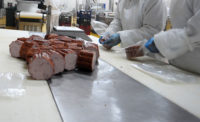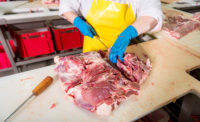The apparel being worn by workers in meat and poultry plants, as well as supermarket perishable departments, is taking on added significance.
With food and worker safety paramount to protein producers, food preparers and consumers, greater emphasis is being given to leveraging the optimal clothing and protective gear for employees. It is to insure that garments do not become sources of foodborne illness or compromise the safety of products.
A major deterrent to transporting pathogens into facilities is requiring employees to change into clean outfits when arriving at a work.
“Workers need to start thinking of clothing as they do their hands, which they typically wash each time they become soiled or dirty,” says Angela Fraser, associate professor in the department of Food, Nutrition and Packaging Sciences at Clemson University in Clemson, S.C. “They can compromise safety by wearing the same dirty clothes to work each day.”
Fraser suggests that facilities have changing areas or locker rooms where employees can switch to clean uniforms.
Companies, she notes, also should require specific protective gear to be worn over clothing based on job functionality. Such items can include plastic disposable aprons and smocks which keep contaminated clothing from contacting products and surfaces.
Indeed, soiled apparel can infect food through direct contact as well as indirectly, such as via a contaminated cutting board.
“For years the world of food safety focused on temperature control, but now noroviruses are being looked at as the No. 1 cause of foodborne disease,” Fraser says. “Workers can repeatedly expose themselves to contaminants by frequently brushing their hands against their infected uniforms.”
To decrease incidents, she recommends that workers continually replace soiled disposable smocks throughout the day; that companies provide laundering services for employee uniforms to insure the garments are suitably treated; and to have management explain proper apparel hygiene to workers.
A course in cleanliness
Such food-safety education includes detailing the importance of properly washing uniforms and the need to refrain from touching clothing, which is akin to contacting a contaminated surface.
Companies that don’t require employees to change into uniforms at facilities, meanwhile, can mandate how often individuals can wear specific clothing to work before the clothing must be cleaned or sanitized.
In addition to disposable aprons and smocks, other apparel that can help shield clothing and workers from contaminants includes sleeve guards and single use gloves. Less significant, however, is head gear, which Fraser says creates more of a perception to the public that an environment is sanitary rather than actually enhancing food safety.
“There are not conclusive research findings that hair is a source of pathogens, unlike skin or clothing,” she states. Yet, while protective gear can create a barrier between contaminated clothing and foods, such items themselves are susceptible to infection. Plastic gloves, for instance, can pick up pathogens when workers contact unsanitary surfaces, such as door handles.
It is important, thus, for companies to also instruct workers on the necessity of replacing apparel after such contact, Fraser says.
“Many non-food contact surfaces also are high-touch areas,” she states. “Food-safety codes often cover the cleaning and sanitizing of food contact surfaces, but they do not typically cover non-food contact areas. Not requiring the removal of pathogens from those areas is a significant gap within the codes.”
It’s a family affair
In addition to creating food-safety issues at plants and retail outlets, contaminated clothing also may impact the health of workers’ families. Gale Prince, president of Cincinnati-based Sage Food Safety Consultants LLC, notes, for instance, that garments worn home from a facility can harbor Salmonella or chemicals.
“A child also may be allergic to an ingredient or dust from a plant that remains on their parent’s clothing,” Prince says. “The hazards go beyond just being microbiological.”
To minimize such health threats, he notes that workers should change out of their soiled clothing before heading home.
“There should be a similar procedure as that followed by many hospital workers where scrubs are kept in the hospital and not worn outside,” says Mel Kramer, president of EHA Consulting Group Inc., a Baltimore-based firm of food safety and infectious epidemiologists. “That is because something as simple as contaminated dangling strings from a hoodie sweatshirt can infect food. That is not good.”
Kramer recommends that companies provide workers with apparel that is laundered and controlled by the employers and to mandate that employees change into the clean uniforms when arriving at plants.
Yet, it also is important for companies to guard against cross-contamination within their facilities by isolating the apparel worn by persons who handle raw meat from other areas of a plant, such as the ready to eat production lines.
Measures can include the adjusting of traffic patterns so persons working in a slaughterhouse, for instance, have to enter a locker room, where they can change apparel and become sanitized before reaching the entryway to the ready to eat section.
The threat of Listeria monocytogenes is perhaps the major hazard that results from bringing contaminants on apparel into plants that process RTE products, Kramer states.
“Raw products are not an issue, as they will be cooked and bacteria will be killed if handled properly,” he says. “But you don’t want contaminated clothes to be inside the ‘clean barrier.’”
Other possible company food-safety regulations can include specifications for how frequently workers must change into freshly laundered outfits, such as daily or whenever apparel become soiled, Prince states. Procedures that govern footwear also are necessary as the soles of street shoes are ripe for contaminants, he adds.
“Many companies are issuing boots that are cleaned and always stay in the plant,” Prince says. “That is imperative because workers who are concerned about damaging their own leather footwear often are reluctant to sanitize their shoes each day when arriving at a facility.”
Determining the optimal ways to clean apparel also can minimize potential infections. Most effective are commercial laundries which specialize in sanitizing outfits, he states.
“Commercial laundries are better able to treat the industrial soils than home washing machines,” Prince says.






